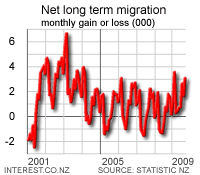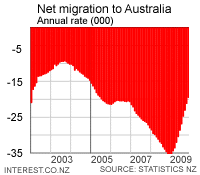 The declining trend of permanent and long-term departures from New Zealand continued in September as net migration to New Zealand continued to rise, figures released by Statistics New Zealand show. (Update 2 includes economist comment.)
Permanent and long term (PLT) arrivals to the country were 3,107 above PLT departures in September, the highest net migration for a September month since 2003 (3,702). Both arrivals and departures fell from September 2008.
Seasonally adjusted net PLT migration was 1,800 in September, up from 1,620 in August and down from 2,480 in July.
Unadjusted figures show there were 4,035 PLT departures in September, down 29% from September 2008. This was the lowest level of departures for a September month since 2003. There were 7,142 PLT arrivals over the month, down 3.9% from a year ago. PLT arrivals were at their lowest level for a September month since 2005.
The declining trend of permanent and long-term departures from New Zealand continued in September as net migration to New Zealand continued to rise, figures released by Statistics New Zealand show. (Update 2 includes economist comment.)
Permanent and long term (PLT) arrivals to the country were 3,107 above PLT departures in September, the highest net migration for a September month since 2003 (3,702). Both arrivals and departures fell from September 2008.
Seasonally adjusted net PLT migration was 1,800 in September, up from 1,620 in August and down from 2,480 in July.
Unadjusted figures show there were 4,035 PLT departures in September, down 29% from September 2008. This was the lowest level of departures for a September month since 2003. There were 7,142 PLT arrivals over the month, down 3.9% from a year ago. PLT arrivals were at their lowest level for a September month since 2005.
 There were 2,127 PLT arrivals of New Zealand citizens in September, compared to 2,431 departures (net 304 departures). This was down from 2,234 net departures of New Zealand citizens in September 2008.
In the year ended September 2009, net PLT migration to New Zealand was 17,043. This was up from 4,403 the previous year and the highest September year since 2004.
ASB economist Jane Turner said the rise in net migration may only be temporary as labour market conditions improve in Australia.
There were 2,127 PLT arrivals of New Zealand citizens in September, compared to 2,431 departures (net 304 departures). This was down from 2,234 net departures of New Zealand citizens in September 2008.
In the year ended September 2009, net PLT migration to New Zealand was 17,043. This was up from 4,403 the previous year and the highest September year since 2004.
ASB economist Jane Turner said the rise in net migration may only be temporary as labour market conditions improve in Australia.
The increase in net migration continues to support growth in household formation and underpin housing demand. The current pick up in the housing market activity (and house prices) should encourage a lift in residential building activity and help construction activity lift off its current lows. However, the rise in net migration may only be temporary. As conditions improve across the Tasman it may be a matter of time before a recovering labour market in Australian provide a lift to permanent departures.Here are Stats NZ's comments on the annual figures:
Annual PLT migration by country In the year ended September 2009, there were net PLT inflows from the United Kingdom (9,200), India (5,900), China (3,600), the Philippines (2,700), Fiji (2,600), South Africa (1,700), and Germany (1,500). The net PLT outflow to Australia was 23,100 in the September 2009 year, compared with a net outflow of 33,900 in the September 2008 year. The annual net outflow to Australia has been decreasing since the record highs of 35,400 in the December 2008 and January 2009 years. The latest net outflow resulted from 37,400 PLT departures to Australia, partly offset by 13,200 PLT arrivals from Australia. Almost 9 in every 10 PLT departures to Australia were New Zealand citizens (32,900). Of the PLT arrivals from Australia, two-thirds were New Zealand citizens (9,500), similar to levels observed over the past decade. Annual PLT migration by citizenship A net inflow of 38,200 non-New Zealand citizens and a net outflow of 21,200 New Zealand citizens were recorded in the year ended September 2009. PLT arrivals of New Zealand citizens numbered 25,600 in the September 2009 year, above the average of 23,400 recorded for the 1979"“2008 December years, but below peaks in the March 1991 year (29,600) and the October 2003 year (27,800). Arrivals of New Zealand citizens tend to show relatively little variation year-to-year, and the variation that does occur often follows trends in departures of New Zealand citizens a few years earlier. PLT departures of New Zealand citizens have shown much more annual variation than arrivals of New Zealand citizens. The highest number of departures of New Zealand citizens was 64,300 in the October 1979 year, but by the January 1984 year, this had decreased to a low of 24,400. There were 46,700 PLT departures of New Zealand citizens in the September 2009 year, down 12,900 from the previous year. PLT arrivals of non-New Zealand citizens were less than 30,000 a year between 1979 and 1992, then doubled to reach a peak of 58,800 in the July 1996 year. Another peak, of 72,800, was reached in the February 2003 year. The changes in arrivals of non-New Zealand citizens reflect changes in arrivals of temporary workers (including working holidaymakers) and overseas students staying for 12 months or more, as well as arrivals for residence. Although arrivals of non-New Zealand citizens have generally been increasing since 2005, the 61,600 arrivals in the September 2009 year were down 1,800 from the September 2008 year. PLT departures of non-New Zealand citizens have generally been increasing since 1984, corresponding with the general increase in arrivals of non-New Zealand citizens. There were 23,400 PLT departures of non-New Zealand citizens in the September 2009 year, up 800 from the September 2008 year. Annual PLT migration by permit type In the September 2009 year, 29,500 PLT arrivals were Australian or New Zealand citizens who did not require a permit to remain in New Zealand. Of the 57,700 PLT arrivals who did require a permit, 22,300 arrived on work permits, 16,000 arrived on student permits, 14,100 arrived on residence permits, and 4,800 arrived on visitor permits. Compared with the September 2008 year, there were more PLT arrivals on student permits (up 1,000), but fewer arrivals on residence permits (down 700). The majority of residence approvals in recent years have been granted onshore, to people who arrived on other permit types. While arrivals on work permits in the September 2009 year were down 900 from the previous year, they have decreased by 1,700 in the combined six months from April to September 2009, compared with the same six months in 2008.Click here to watch this morning's video.

We welcome your comments below. If you are not already registered, please register to comment
Remember we welcome robust, respectful and insightful debate. We don't welcome abusive or defamatory comments and will de-register those repeatedly making such comments. Our current comment policy is here.